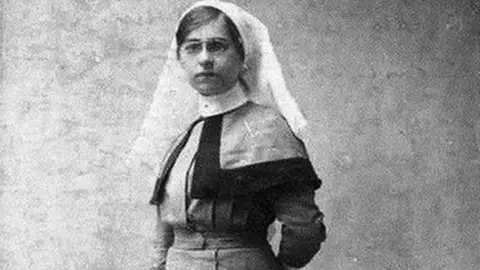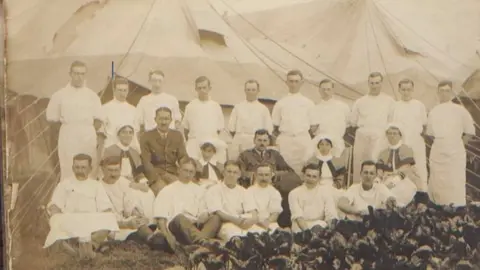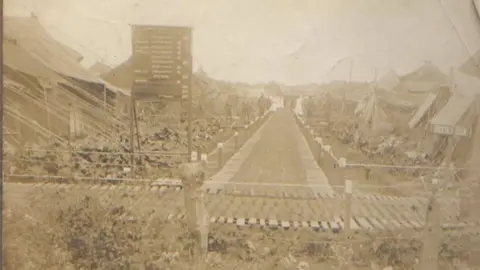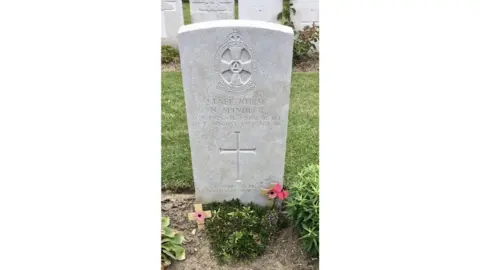Passchendaele's untold army of women nurses
 BBC
BBC"No words of mine can soften the blow. There is one consolation for you - your daughter became unconscious immediately after she was hit, and she passed away perfectly peacefully."
This was how Minnie Wood, a 36-year-old matron, comforted the parents of one of her young nurses, Nellie Spindler, who was killed by a shell during the First World War's Battle of Passchendaele in 1917.
According to Minnie's letter, 26-year-old Nellie "was oblivious to her surroundings" as she died from a blast at the hospital where they worked, which was three miles from the front line.
"Shells continued to fall in for the rest of the day," wrote Minnie, who ran to the scene of the bomb and held Nellie in her arms as she died.
The battle of Passchendaele was fought near Ypres between 31 July and 10 November 1917, in battlefields that turned to liquid mud.
But women, as well as soldiers, braved the relentless rain and shell fire of the three-month battle - and efforts have recently been made to shed light on their experiences.
'Incredibly sheltered'
"I'm astounded by what the nurses did and how they kept calm despite absolute horror," says Capt Amelia Cummings, a military nurse from the Queen Alexandra's Royal Army Nursing Corps, the same group of nurses which served in Ypres.
On Monday, she will join thousands of relatives of soldiers who fought at Passchendaele for a service at Tyne Cot Cemetery near Ypres, to mark 100 years since the battle began.
"With the amount of training we do now, we're so prepared for conflict," says Capt Cummings, who was posted to Afghanistan in 2014, where she says nurses also had to deal with bomb attacks and "constantly develop our practices".
She adds: "Most Queen Alexandra's nurses were aristocratic ladies whose lives would have been incredibly sheltered before they dealt with the injuries from mechanised war."

Nellie, from Wakefield, West Yorkshire, who was also a Queen Alexandra's nurse, was buried with military honours near where she worked at Lijssenthoek, west of Ypres.
She is the only woman alongside 10,000 men buried there - but the only detail that marks the difference between her headstone and a soldier's is her rank: "Staff Nurse".
According to the Commonwealth War Graves Commission's database, she is one of two women buried in Belgium, compared with 122 women from World War One buried in France, where most major hospitals were based.
But little is known about many of the nurses who survived the battle.
Prof Christine Hallett, author of Nurses of Passchendaele, has recently pieced together many of their letters and diaries, and says "more could be done to highlight their sacrifices".
She says: "They were not frail things who needed protecting by the men - many soldiers could not have survived without the nurses' care."

An estimated 50 to 100 nurses worked across a complex of hospitals and casualty clearing stations around the battlefields of Ypres.
"It was terrifying lying in bed, expecting every minute to be blown to pieces," wrote one sister, Mary Tilton, whose camp was so close to German lines that they "peppered us with bombs".
She says she tried to laugh off the danger as she "could not control the violent trembling of my legs - my knees positively knocked together".
Another anonymous account of the battle reveals how Violetta Thurstan, a nurse from Ore in Sussex, "dragged a wounded man into a shelter at great personal risk" before assisting an operation in a makeshift hut - "though at the time the shelling was very heavy".
By 1917, nurses were closer to the battlefield than at any point during the war - a distance of around three miles.
The proximity to the front line saved lives but, after Nellie's death on 21 August 1917, the decision was made to move hospitals further back.
Women's work?
With the campaign for women's suffrage suspended during the war, nurses saw the opportunity to improvise with what was a strictly-defined role at home.
"Don't think about the pretty nurse in the uniform with the brave soldier," says Dr Emily Mayhew, Imperial College London's historian-in-residence.
"By Passchendaele, the military medical system was the best it's ever been and nurses were really important to that."
Traditional tasks such bed-making and cleaning patients and wards were part of a Passchendaele nurse's job - but by 1917 the roles had transformed.
They had learned the best way to treat shock using a mixture of saline, coffee and brandy - and were among the first women to work as anaesthetists and perform surgery.
"It was the most demanding job you could ask of anyone and they did it every day," Dr Mayhew says.

The "most remarkable" job was the way they cared for the dying, she says.
If a patient had no hope, they were taken to a ward where no doctors entered. A nurse would speak to him, brush his hair, give him sips of water until he died - all the time recording everything their patient said.
"One nurse had to write 66 letters in one day to families, either warning their son was about to die or recording their final moments," says Dr Mayhew.
"Families would get an official telegram, but by the next post receive a letter from a lovely efficient lady with good handwriting - you can imagine how comforting that would have been."

Military nurses do the same today, during the conflict in Afghanistan - writing patient diaries as part of caring for critically-ill soldiers.
"It's very much the same thing," says Dr Mayhew. "Illuminating that moment of darkness as much as possible - a nurse by a bedside, with pen and paper."
Capt Cummings says that, 100 years later, the Passchendaele nurses still give her corps a sense of "immense pride".
"These nurses showed that women have long been near the front line in one role or another. As the years go on, hopefully their memory won't fade."
